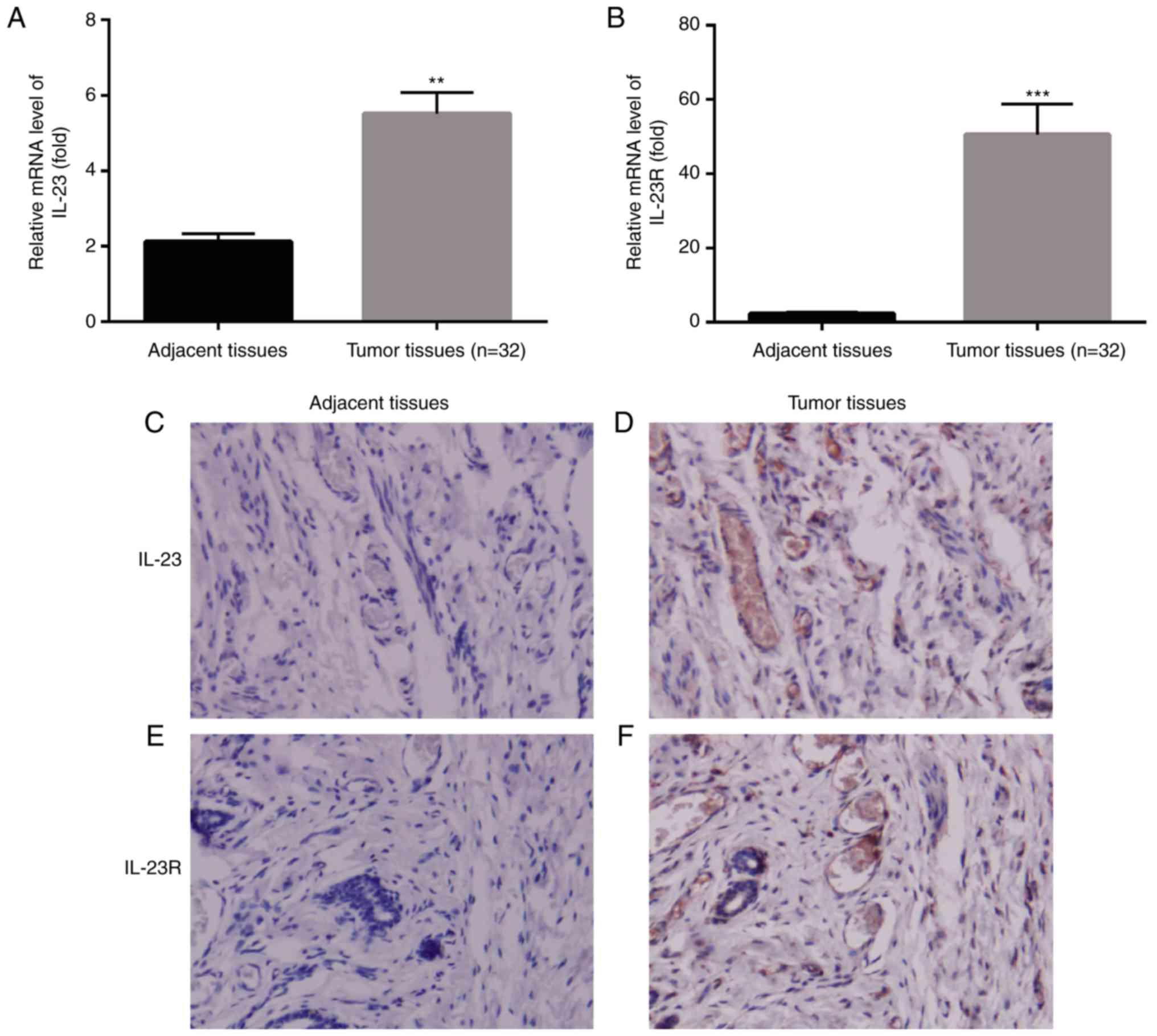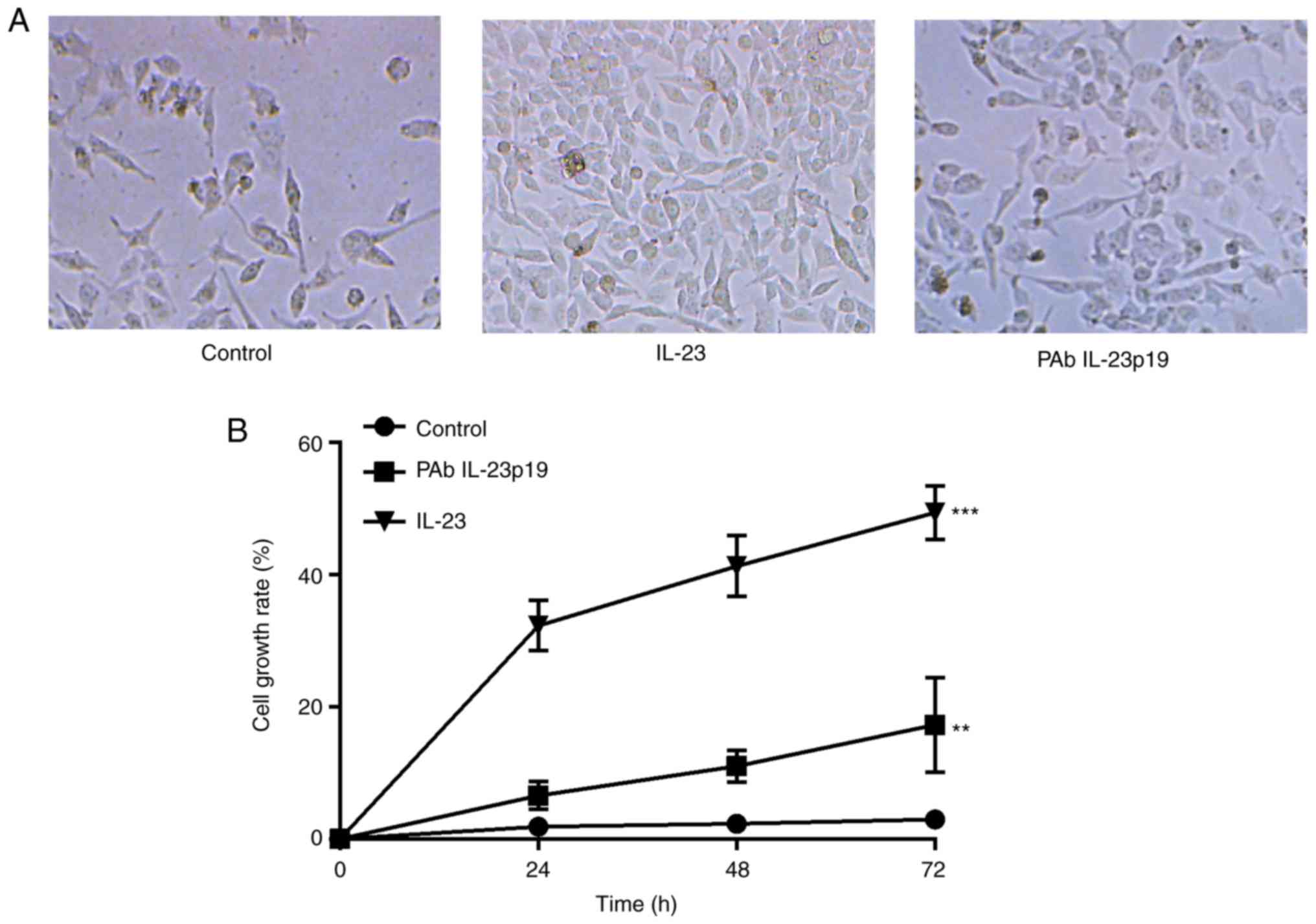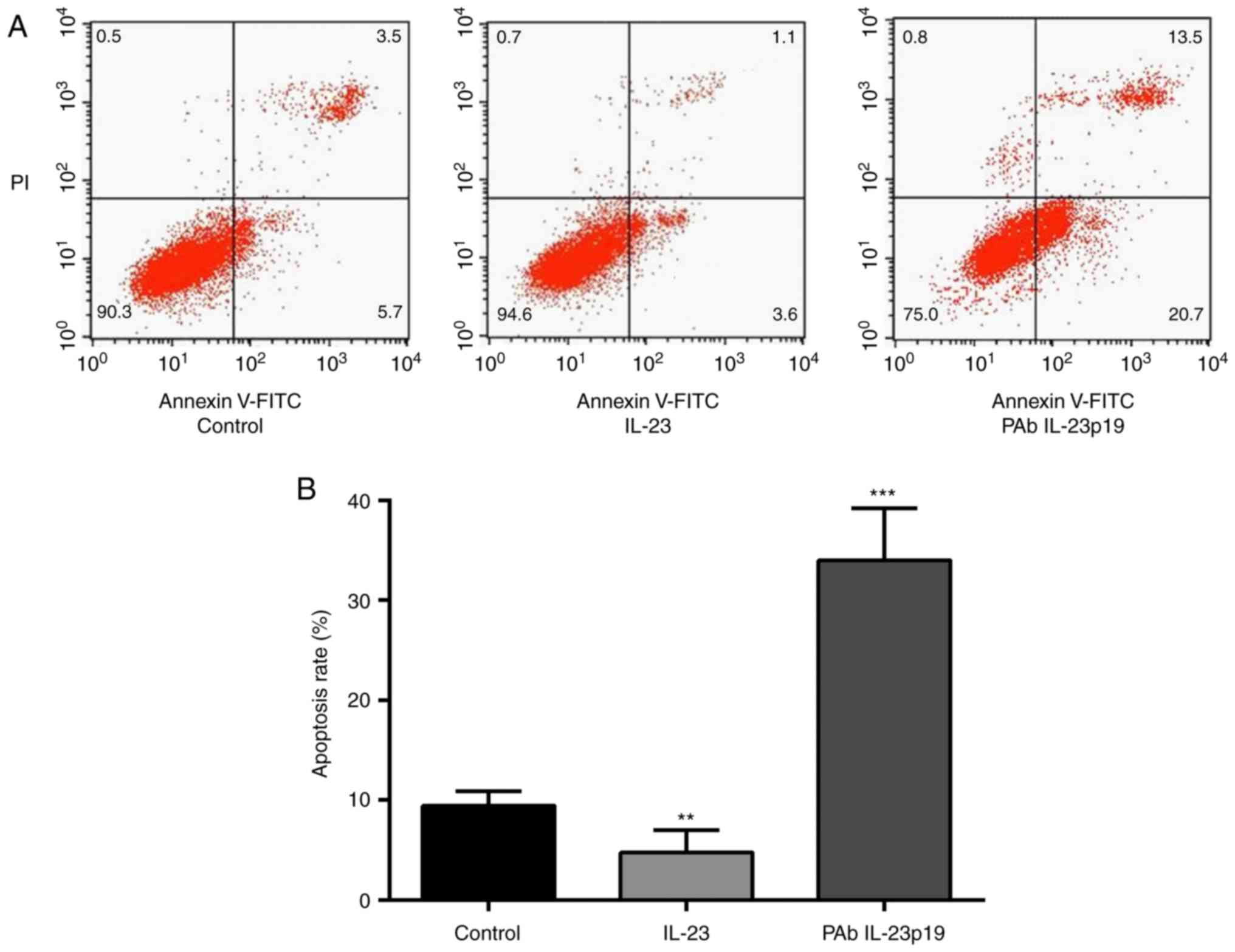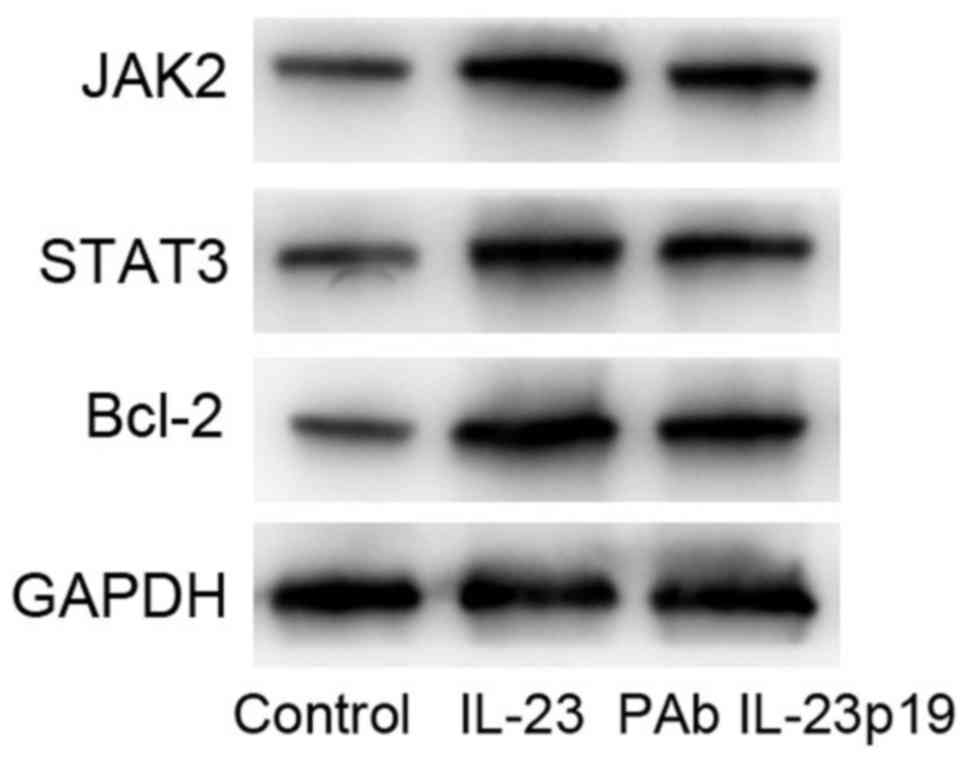Aberrant expression of IL-23/IL-23R in patients with breast cancer and its clinical significance
- Authors:
- Published online on: January 12, 2018 https://doi.org/10.3892/mmr.2018.8427
- Pages: 4639-4644
Abstract
Introduction
Globally, breast cancer (BC) is the most frequently diagnosed cancer in women and accounts for more than 1 million new cases yearly (1). Despite the mortality of breast cancer has been reduced dueing to the early detection and adjuvant treatments, more than 450,000 deaths still occur each year (2). As acknowledged, breast cancer is a complex and heterogeneous disease which is accompanied with dissimilar cellular origin, etiology, treatment responses or clinical outcomes (3). Current therapies for breast cancer which are customized are based on molecular profiles including luminal, basal-like and human epidermal growth factor receptor-2 positive, and contain chemotherapy, endocrine therapy, selective estrogen receptor modulators and targeted therapies (4).
Interleukin (IL)-23 is a pro-inflammatory cytokine which consists of IL-12 p40 and IL-23 p19 subunits. IL-23, which is primarily secreted by macrophages and dendritic cells, induces autoimmunity by T-cell-mediated inflammation through impacting T helper 17 (Th17) cell response (5). Inappropriate expression of IL-23 appeared to coincide with multiple autoimmune disorders (6,7). Furthermore, previous studies indicate that IL-23/IL-23R is indispensable for Th17 cell-mediated immune response (8,9), and IL-23R plays a crucial role in initiating, maintaining and accelerating IL-23/IL-17 inflammatory signaling pathway (10). The importance of IL-23R during the development of tumor and the effects on tumor immunity was previously elucidated (11); meanwhile, IL-23R was indicated to exert an immunosurveillance function by CD8+ T-cells and accelerate tumor growth in a previous study (12).
The correlation between chronic inflammation and elevated malignancy incidence or the regulatory mechanisms has been suggested for more than a century (13). The current study aimed to explore the effects of IL-23/IL-23R on breast cancer, and provide a therapeutic target for breast cancer.
Materials and methods
Participants
Breast cancer tissues and the adjacent tissues were gathered from thirty-two patients who were treated in our hospital. Basic characteristics of patients were presented in Table I. Prior written and informed consent were obtained from each patient before the beginning of our research. Current research was approved by the Ethics Committee of The Third Hospital of Chengde City.
Table I.IL-23/IL-23R mRNA level was correlated with clinicopathological parameters of breast cancer patients. |
Cell culture
MCF7 cells were maintained in Dulbecco's modified Eagle's medium (DMEM)/Ham's F12 medium with 10% fetal bovine serum, 100 U/ml penicillin and 100 µg/ml streptomycin. And incubated in a humidified atmosphere of 5% CO2 at 37°C.
Recombinant human (rh) IL-23 (R&D) was used for the stimulation of the cells. Effects of rh IL-23 (10 ng/ml) on cell proliferation were detected after cells were incubated with it 48 h; the influence of pre-treatment of PAb IL-23p19 (Santa Cruz Biotechnology, Inc., Dallas, TX, USA), a neutralizing antibody specific for IL-23, on rh IL-23 treated cells were also examined (14). Therefore, cells were divided into 3 groups, i.e., control group, IL-23 group (cells treated with rh IL-23) and PAb IL-23p19 group (cells treated with PAb IL-23p19 and rh IL-23) to investigate cell behaviors and correlated protein expression levels.
Real-time PCR analysis of IL-23R messenger RNA
Tumor tissues and the adjacent tissues of thirty-two breast cancer patients were extracted and stored at −80°C or applied for the following experiments. Total RNA was isolated by TRIzol (Molecular Research Center, Cincinnati, OH, USA). cDNA was obtained from mRNA with oligo primers and Superscript II (Invitrogen; Thermo Fisher Scientific, Inc., Waltham, MA, USA) based on the manufacturer's protocol. Relative gene level for IL-23R was quantified by ABI Prism 7000 (Applied Biosystems; Thermo Fisher Scientific, Inc., Waltham, MA, USA) based on the method of SYBR-Green. Primers were as followed: IL-23, forward: TGCTAGGATCGGATATTTTCACAGG; reverse: GAGGCTTGGAATCTGCTGAGTC; IL-23R, forward: GATATTCCTGATGAAGTAACCTGTGT. C; reverse: GATACTGTTGCTCTTCTTCTGTCTC; GAPDH, forward: CAGCCTCAAGATCATCAGCA; reverse: ACAGTCTTCTGGGTGGCAGT, which were as previously reported study performed (14). Total volume of PCR reaction was 20 µl which consisted of 0.1 µM forward/reverse primer, 1× SYBR Premix EX Taq premix (Takara Biotechnology Co., Ltd., Dalian, China) and 50 ng cDNA. The conditions were: 95°C for 120 sec, followed by 40 cycles at 95°C for 15 sec and 60°C for 60 sec. GAPDH was used as an internal reference gene.
Immunological histological chemistry
Tissues from patients were first sliced into 4 mm-thick sections. Afterwards, sections were fixed by 7.5% buffered formalin and embedded with paraffin. Then deparaffinage and antigen retrieval of slices were performed before incubation with antibody. Avidin-biotin-peroxidase complex (ABC) method was conducted with monoclonal IL-23 antibody and IL-23R antibody according to the manufacturer's protocol. The expression levels of IL-23 and IL-23R were independently assessed by three senior pathologists in accordance with the proportion and intensity of positive cells.
MTT assay
Cell proliferation was examined by MTT assay. Briefly, cells (1×105) were seeded into 12-well plate and incubated with methamphetamine for 24 h. MTT (5 mg/ml in PBS) was added into the wells, and cells were incubated for another 1.5 h at 37°C. After extraction and throwing away the supernatant from the culture medium, dimethylsulfoxide (200 µl) was added to dissolve the formazan crystals. The optical density (OD) on a spectrophotometer was measured at 595 nm.
Cell apoptosis analysis
Cells were seeded in 12-well plates and cultured for 48 h in an incubator at 37°C with humidified atmosphere of 5% CO2. A total of 1×105 cells were collected by centrifugation (2,000 rpm, 5 min) and washed by ice-cold PBS. Afterwards, cells were fixed with ice-cold ethanol (70%) and placed at −20°C overnight. On the next day, cells were stained by Annexin V-enhanced green fluorescent protein (FITC) and propidium iodide (PI), then incubated for 15 min at room temperature in dark place. Assay results were measured by Cell Quest software (BD Biosciences, Franklin Lakes, NJ, USA). The percentage of cells with apoptotic nuclei was calculated.
Western blot analysis
Cell were rinsed twice with ice cold PBS and scraped by RIPA (Beyotime Institute of Biotechnology, Shanghai, China). Samples were separated by 10% sodium dodecyl sulfate polyacrylamide gel electrophoresis. Then, gels were transferred onto polyvinylidene difluoride membranes at 4°C. Membranes reacted with primary antibody overnight at 4°C, and horseradish peroxidase-conjugated secondary antibody for 90 min at room temperature with gentle agitation. Finally, at room temperature, after washing with Tris Buffered Saline with Tween 20 (TBST) for 10 min, proteins were detected with Super Signal West Pico Chemiluminescent Substrate (Thermo Fisher Scientific, Inc.).
Statistical analysis
Data were analyzed by SPSS v21.0 (SPSS, Inc., Chicago, IL, USA) and presented as mean ± standard error of mean (SEM). Data were analyzed by t-test. P<0.05 was considered to indicate a statistically significant difference.
Results
mRNA level of IL-23/IL-23R is higher in breast cancer tissues than the adjacent tissues
Previous study has reported the differences of IL-23 mRNA expression level between tumor tissues and the adjacent normal tissues in numerous types of organs, including conlon, ovarian, lung, stomach and breast, among all of which there was significant up-regulation of IL-23 mRNA level in tumor tissues than in the normal tissues (12). In our present study, we also first explored the differences of IL-23 mRNA level between breast cancer tissue and the adjacent normal tissue by RT-PCR. Results indicated that, IL-23 mRNA level was also significantly higher in tumor tissue in comparison with the normal tissue (P<0.01, n=32, Fig. 1A), which was in consistent with the previous reported study (12). Moreover, IL-23 was considered as a prognostic factor in breast cancer patients which was reported by Gangemi et al (15). Therefore, we put forward a hypothesis that IL-23-mediated responses might be crucial for the promotion of tumor.
Studies found that genetic variants of IL-23R might contribute to the pathological development of hepatitis to HCC (16); while hepatitis B virus could induce hepatitis by elevating IL-23 expression and lead to liver damage via IL-23/IL-17 axis (17). IL-23R plays a crucial role in initiating, maintaining and accelerating IL-23/IL-17 inflammatory signaling pathway (10). Since IL-23 mRNA level was upregulated in breast cancer tissue than in the adjacent normal tissue, we were eager to know the changes of IL-23R between tumor tissue and the normal tissue. RT-PCR results exhibited that, there was much higher mRNA level of IL-23R in breast cancer tissue compared to the normal tissue (P<0.001, n=32, Fig. 1B).
Meanwhile, we detected the protein levels of IL-23 and IL-23R in the adjacent tissues and tumor tissues from patients by immunohistochemistry. We found that, both IL-23 and IL-23R exhibited much more expression level in tumor tissues in comparison with the adjacent tissues (Fig. 1C-F).
Correlation between IL-23/IL-23R and patients' characteristics
Both IL-23 and IL-23R were positively correlated with patients' tumor size, TNM stage and metastasis. Patients were divided into two groups according to the age, there were 17 patients aged ≥40 and 15 patients aged <40, IL-23 and IL-23R in patients aged ≥40 years old were higher than in patients aged <40 years old, however, there was no significant difference; as for histological grade, there were 11 patients showed well-intermediately differentiation while 21 patients showed poor differentiation, IL-23/IL-23R in poor differentiation was a little lower than in well-intermediately differentiation, whereas, there was no significant difference; regarding invasion depth, there were 25 patients at T1-T2 and 7 patients at T3-T4, we found that, IL-23/IL-23R levels were higher in T3-T4 group than in T1-T2 group, however, there was no significant difference (Table I).
Pre-treatment of PAb IL-23p19 repressed IL-23 induced cell proliferation
To investigate whether IL-23 could induce cell proliferation of breast cancer cells, cell proliferation assay was performed. Cell proliferation rate revealed to be distinctly increased by treatment with 10 ng/ml rhIL-23 in comparison with the untreated control (P<0.001, n=3, Fig. 2A and B). Cells were further treated with IL-23 at the presence of PAb IL-23p19, PAb IL-23p19 abolished the induction of cell proliferation by IL-23 (P<0.01, n=3, Fig. 2A and B). Taken together, these results demonstrated that, the promotion of cell proliferation was an effect of IL-23 in breast cancer cell line, which could be distinctly inhibited by the pre-treatment of PAb IL-23p19.
Pre-treatment of PAb IL-23p19 induced IL-23 repressed cell proliferation
To investigate whether IL-23 could inhibit cell apoptosis of breast cancer cells, FCM assay was carried out. Cell apoptosis rate revealed to be distinctly decreased by 10 ng/ml rhIL-23 in comparison with control group (P<0.01, n=3, Fig. 3A and B). Cells were further treated with IL-23 at the presence of PAb IL-23p19, PAb IL-23p19 abolished the inhibition of cell apoptosis by IL-23 (P<0.001, n=3, Fig. 3A and B). Taken together, these results suggested that, the inhibition of cell apoptosis is also an effect of IL-23 in breast cancer cell line, which could be abolished by the pre-treatment of PAb IL-23p19.
Pre-treatment of PAb IL-23p19 inhibited the activation of JAK2/STAT3 signaling pathway induced by IL-23
Recent evidence indicated that IL-23-mediated responses were crucial in promoting tumor progression of various tissues. IL-23 signaling occurred by activation of the JAK/STAT (specifically STAT3) pathway, thus resulting in up-regulation of proteins which were linked with proliferation, survival (bcl-x), metastasis (VEGF, HIF1α, MMP2, MMP9), angiogenesis and immunosuppression, etc (18). Consequently, we tested the expression levels of STAT3, JAK2 and bcl-2 in MCF-7 cells by western blot. Results showed that, the activation levels of STAT3 and JAK2 were induced by IL-23, and pre-treatment of PAb IL-23p19 inhibited the activation of STAT3 and JAK2. Meanwhile, bcl-2 protein expression was also upregulated by IL-23, which was downregulated by pre-treatment of PAb IL-23p19 (Fig. 4). These results suggested that, pre-treatment of PAb IL-23p19 abolished IL-23-mediated aberrant cell proliferation and apoptosis by inhibiting the activation of JAK2/STAT3 signaling pathway and reduced the expression of bcl-2.
Discussion
IL-23 was identified as a cancer-related cytokine in a recent study. The expression of IL-23 was significantly increased in majority of human tumors from various organs compared to normal adjacent tissues (12). As acknowledged, multiple cancers arose from chronic inflammation and inflammatory mediators were synthesized by tumors (19,20). The ability to respond to IL-23 is determined by the expression level of IL-23R in cells (21).
In our study, we indicated that mRNA and protein levels of IL-23 and its receptor IL-23R were constitutively co-expressed in breast cancer tissues, and IL-23/IL-23R was increased in breast cancer tissues in comparison with the adjacent tissues (Fig. 1), which was in consistent with a previous reported research (12). Taken together, the results verified the potential of IL-23 as a prognosis factor in breast cancer.
Thereafter, we determined the effects of IL-23 on breast cancer cell line MCF-7 behaviors, and studied whether a neutralizing antibody specific for IL-23, PAb IL-23p19 could attenuate the effects of IL-23.
To investigate whether IL-23 could induce cell proliferation of breast cancer cells, cell proliferation assay was carried out. Cell proliferation rate revealed to be distinctly increased by treatment with rhIL-23 in comparison with control; cells were further treated with IL-23 at the presence of PAb IL-23p19, and PAb IL-23p19 abolished IL-23 induced cell proliferation (Fig. 2A and B).
We also investigate whether IL-23 could inhibit cell apoptosis of breast cancer cells, FCM assay was carried out. Cell apoptosis rate revealed to be distinctly decreased by rhIL-23 in comparison with control; cells were further treated with IL-23 at the presence of PAb IL-23p19, PAb IL-23p19 abolished the inhibition of cell apoptosis by IL-23 (Fig. 3A and B).
Taken together, these results suggested that, the inhibition of cell apoptosis and promotion of cell proliferation by IL-23 could be abolished by pre-administration of PAb IL-23p19. Whereas, it was unclear which signaling pathway did IL-23 depend on to function.
IL-23-mediated responses were indicated to be crucial in promoting tumor progression. IL-23 signaling occurred by activating JAK/STAT3 pathway, up-regulating proteins that were correlated with proliferation and survival (bcl-x) (18). The JAK-STAT signaling cascade consisted of three main components: One Janus kinase (JAK, a cell surface receptor) and two signal transducer and activator of transcription (STAT) proteins; JAK-STAT signaling pathway transmitted information from extracellular chemical signals to nucleus, generating DNA transcription and expression of genes which were correlated with proliferation, apoptosis and oncogenesis (22). Disruption or dysregulation of JAK-STAT functionality lead to immune deficiency syndromes and cancers (22). Activated JAKs phosphorylated tyrosine residues on the receptor, creating binding sites for proteins which possessed SH2 domains; SH2 domain containing STATs were recruited to the receptor and tyrosine-phosphorylated (activated) by JAKs followed by forming hetero- or homodimers and translocating to the cell nucleus to induce target gene transcription (23). Moreover, activation of JAK2/STAT3 pathway contributed to the poor outcomes of metastatic breast cancers (24,25).
Consequently, we tested the expression levels of STAT3, JAK2 and bcl-2 in MCF-7 cells by western blot. Results showed that, the activation levels of STAT3 and JAK2 were induced by IL-23, and pre-treatment of PAb IL-23p19 inhibited the activation of STAT3 and JAK2. Meanwhile, bcl-2 protein expression was also upregulated by IL-23, which was downregulated by pre-treatment of PAb IL-23p19 (Fig. 4). These results suggested that, pre-treatment of PAb IL-23p19 abolished IL-23-mediated aberrant cell proliferation and apoptosis by inhibiting the activation of JAK2/STAT3 signaling pathway and reduced the expression of bcl-2.
In conclusion, blocking the function of IL-23 inhibited the proliferative activity and induced the apoptotic activity of tumor cells via inhibiting the activation of JAK2/STAT3 pathway in MCF-7 cells. We provide a potential therapeutic target for breast cancer.
References
|
Siegel R, Naishadham D and Jemal A: Cancer statistics, 2013. CA Cancer J Clin. 63:11–30. 2013. View Article : Google Scholar : PubMed/NCBI | |
|
Jemal A, Siegel R, Xu J and Ward E: Cancer statistics, 2010. Cancer J Clin. 60:277–300. 2010. View Article : Google Scholar | |
|
Cardoso F, Harbeck N, Barrios CH, Bergh J, Cortés J, EI Saghir N, Francis PA, Hudis CA, Ohno S, Partridge AH, et al: Research needs in breast cancer. Ann Oncol. 28:208–217. 2017.PubMed/NCBI | |
|
Harbeck N and Gnant M: Breast cancer. Lancet. 389:1134–1150. 2017. View Article : Google Scholar : PubMed/NCBI | |
|
Ahern PP, Izcue A, Maloy KJ and Powrie F: The interleukin-23 axis in intestinal inflammation. Immunol Rev. 226:147–159. 2008. View Article : Google Scholar : PubMed/NCBI | |
|
Langrish CL, Chen Y, Blumenschein WM, Mattson J, Basham B, Sedgwick JD, McClanahan T, Kastelein RA and Cua DJ: IL-23 drives a pathogenic T cell population that induces autoimmune inflammation. J Exp Med. 201:233–240. 2005. View Article : Google Scholar : PubMed/NCBI | |
|
Lee E, Trepicchio WL, Oestreicher JL, Pittman D, Wang F, Chamian F, Dhodapkar M and Krueger JG: Increased expression of interleukin 23 p19 and p40 in lesional skin of patients with psoriasis vulgaris. J Exp Med. 199:125–130. 2004. View Article : Google Scholar : PubMed/NCBI | |
|
Chen Z, Laurence A and O'Shea JJ: Signal transduction pathways and transcriptional regulation in the control of Th17 differentiation. Semin Immunol. 19:400–408. 2007. View Article : Google Scholar : PubMed/NCBI | |
|
Volpe E, Servant N, Zollinger R, Bogiatzi SI, Hupé P, Barillot E and Soumelis V: A critical function for transforming growth factorbeta, interleukin 23 and proinflammatory cytokines in driving and modulating human T(H)-17 responses. Nat Immunol. 9:650–657. 2008. View Article : Google Scholar : PubMed/NCBI | |
|
Cho JH and Weaver CT: The genetics of inflammatory bowel disease. Gastroenterology. 133:1327–1339. 2007. View Article : Google Scholar : PubMed/NCBI | |
|
Le Gouvello S, Bastuji-Garin S, Aloulou N, Mansour H, Chaumette MT, Berrehar F, Seikour A, Charachon A, Karoui M, Leroy K, et al: High prevalence of Foxp3 and IL17 in MMR proficient colorectal carcinomas. Gut. 57:772–779. 2008. View Article : Google Scholar : PubMed/NCBI | |
|
Langowski JL, Zhang X, Wu L, Mattson JD, Chen T, Smith K, Basham B, McClanahan T, Kastelein RA and Oft M: IL-23 promotes tumor incidence and growth. Nature. 442:461–465. 2006. View Article : Google Scholar : PubMed/NCBI | |
|
Balkwill F and Mantovani A: Inflammation and cancer: Back to Virchow? Lancet. 357:539–545. 2001. View Article : Google Scholar : PubMed/NCBI | |
|
Fukuda M, Ehara M, Suzuki S and Sakashita H: Expression of interleukin-23 and its receptors in human squamous cell carcinoma of the oral cavity. Mol Med Rep. 3:89–93. 2010.PubMed/NCBI | |
|
Gangemi S, Minciullo P, Adamo B, Franchina T, Ricciardi GR, Ferraro M, Briguglio R, Toscano G, Saitta S and Adamo V: Clinical significance of circulating interleukin-23 as a prognostic factor in breast cancer patients. J Cell Biochem. 113:2122–2125. 2012. View Article : Google Scholar : PubMed/NCBI | |
|
Xu Y, Liu Y, Pan S, Liu L, Liu J, Zhai X, Shen H and Hu Z: IL-23R polymorphisms, HBV infection and risk of hepatocellular carcinoma in a high-risk Chinese population. J Gastroenterol. 48:125–131. 2013. View Article : Google Scholar : PubMed/NCBI | |
|
Wang Q, Zhou J, Zhang B, Tian Z, Tang J, Zheng Y, Huang Z, Tian Y, Jia Z, Tang Y, et al: Hepatitis B virus induces IL-23 production in antigen presenting cells and causes liver damage via the IL-23/IL-17 axis. PLoS Pathog. 9:e10034102013. View Article : Google Scholar : PubMed/NCBI | |
|
Yu H, Kortylewski M and Pardoll D: Crosstalk between cancer and immune cells: Role of STAT3 in the tumour microenvironment. Nat Rev Immunol. 7:41–51. 2007. View Article : Google Scholar : PubMed/NCBI | |
|
Coussens LM and Werb Z: Inflammation and cancer. Nature. 420:860–867. 2002. View Article : Google Scholar : PubMed/NCBI | |
|
Balkwill F, Charles KA and Mantovani A: Smoldering and polarized inflammation in the initiation and promotion of malignant disease. Cancer Cell. 7:211–217. 2005. View Article : Google Scholar : PubMed/NCBI | |
|
Parham C, Chirica M, Timans J, Vaisberg E, Travis M, Cheung J, Pflanz S, Zhang R, Singh KP, Vega F, et al: A receptor for the heterodi-meric cytokine IL-23 is composed of IL-12Rbeta1 and a novel cytokine receptor subunit, IL-23R. J Immunol. 168:5699–5708. 2002. View Article : Google Scholar : PubMed/NCBI | |
|
Aaronson DS and Horvath CM: A road map for those who don't know JAK-STAT. Science. 296:1653–1655. 2002. View Article : Google Scholar : PubMed/NCBI | |
|
Hebenstreit D, Horejs-Hoeck J and Duschl A: JAK/STAT-dependent gene regulation by cytokines. Drug News Perspect. 18:243–249. 2005. View Article : Google Scholar : PubMed/NCBI | |
|
Marotta LL, Almendro V, Marusyk A, Shipitsin M, Schemme J, Walker SR, Bloushtain-Qimron N, Kim JJ, Choudhury SA, Maruyama R, et al: The JAK2/STAT3 signaling pathway is required for growth of CD44+CD24 stem cell-like breast cancer cells in human tumors. J Clin Invest. 121:2723–2735. 2011. View Article : Google Scholar : PubMed/NCBI | |
|
Hennessy BT, Gonzalez-Angulo AM, Stemke-Hale K, Gilcrease MZ, Krishnamurthy S, Lee JS, Fridlyand J, Sahin A, Agarwal R, Joy C, et al: Characterization of a naturally occurring breast cancer subset enriched in epithelial-to-mesenchymal transition and stem cell characteristics. Cancer Res. 69:4116–4124. 2009. View Article : Google Scholar : PubMed/NCBI |













